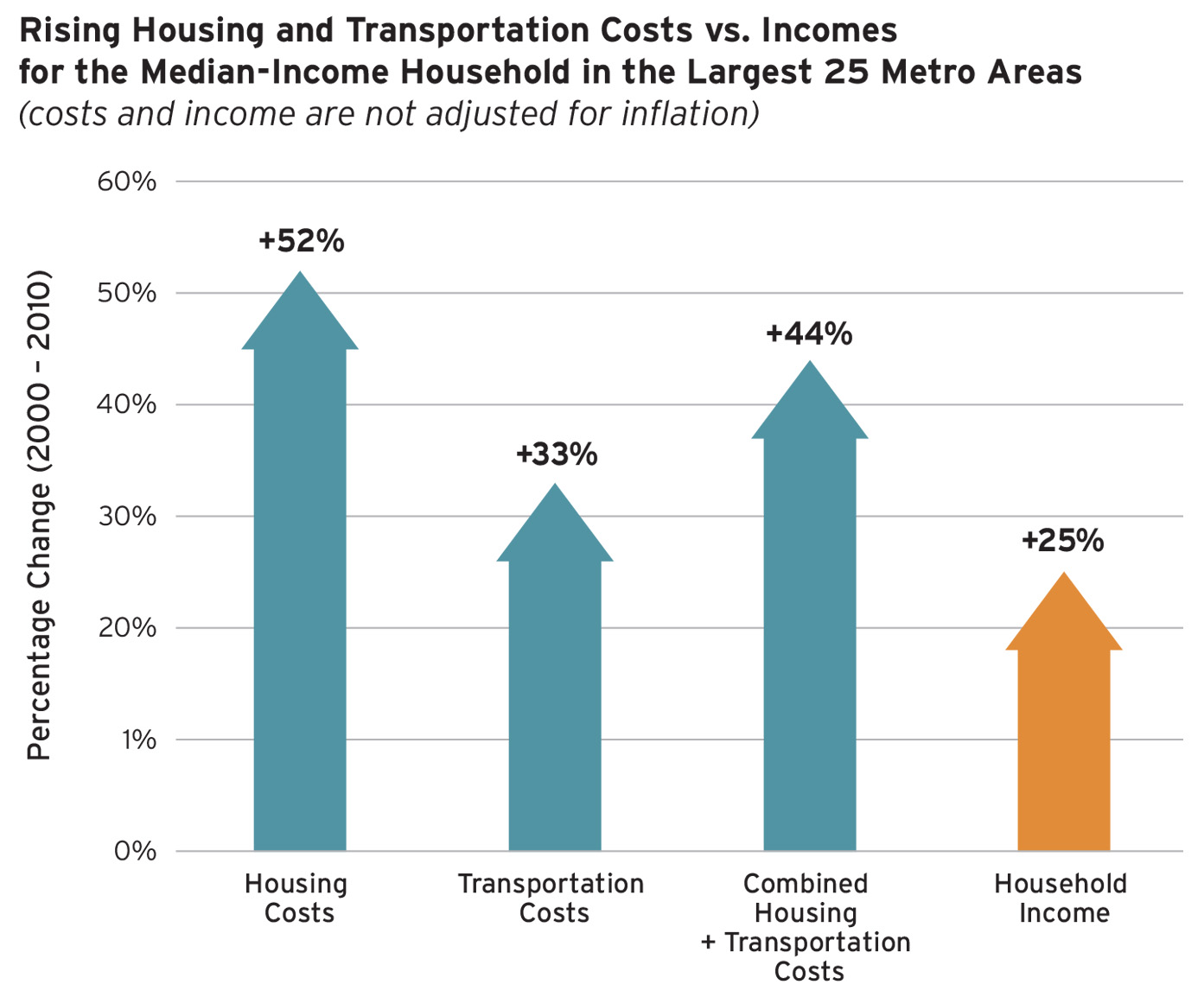 Average moderate-income household in 25 largest U.S. metro areas spends nearly 60 percent of income on housing and transportation
Average moderate-income household in 25 largest U.S. metro areas spends nearly 60 percent of income on housing and transportation
WASHINGTON—The combined costs of housing and transportation in the nation’s largest 25 metro areas have swelled by 44 percent since 2000 while incomes have failed to keep pace, according to a new report from the Center for Housing Policy—the research affiliate of the National Housing Conference—and the Center for Neighborhood Technology. The report, Losing Ground: The Struggle of Moderate-Income Households to Afford the Rising Costs of Housing and Transportation, details the challenges that American households face as the combined costs of housing and transportation consume an ever-larger share of household incomes.
The report includes a special focus on moderate-income households, defined as those earning between 50 and 100 percent of the median household income in their area. In the 25 largest metro areas, the report finds that moderate-income households spend an average of 59 percent of their income on housing and transportation. The report finds cost burdens to be highest in the Miami area, where moderate-income households spend 72 percent of their income on housing and transportation. The next highest burdens are in the Riverside-San Bernardino, Calif., area (69 percent), the Tampa area (66 percent), and the Los Angeles area (65 percent)
“If we really want to understand whether housing is affordable, we need to consider housing and transportation costs together,” explains Center for Housing Policy Executive Director Jeffrey Lubell. “Along with utilities, which we include within housing costs, these are the true ‘costs of place,’ and our report shows they have grown much faster than incomes since 2000.”
The report finds that housing and transportations costs have increased 44 percent over this period while household incomes have risen only 25 percent. As a result, Americans are now substantially less able to afford their costs of place, undermining their ability to meet other critical household expenses, such as food, clothing, health insurance and child care.
Cost burdens have increased despite reductions in home sale prices caused by the major housing downturn that began in 2006. “Increased demand for rental housing combined with insufficient new production has raised rents,” continued Lubell, “while households with blemished credit and existing homeowners with underwater mortgages have been unable to take advantage of lower home prices. Add in the higher transportation costs associated with higher gas prices, stagnant or slowly growing wages and the loss of income associated with layoffs and it’s easy to see how Americans have lost ground.”
“Both housing and transportation costs need to be made more affordable,” notes Center for Neighborhood Technology President and Co-Founder Scott Bernstein. “Letting the public know that the full cost of a location includes both housing and transportation is a first step; targeting resources that lower the cost of transportation, such as improved public transportation, to areas where it will help America’s working families, is also essential.”
The report notes that there are many policies that local and state governments can adopt to help reduce housing costs in places where transportation costs are low or where public investments will make transportation more affordable in the future. Policy options include taking measures to preserve existing affordable housing, reforming restrictive regulations to lower the cost of creating new housing in such areas, and instituting requirements or incentives to include affordable housing as part of new development.
“Given the substantial increases that we expect in coming years in the demand for housing within walking distance of public transit,” explains Bernstein, “it will be essential to act proactively to ensure that affordable housing is preserved and included within new development in these areas.”
Key Findings
- · Housing and transportation costs have gone up faster than incomes for American households. Since 2000, combined housing and transportation costs have risen 44 percent in the 25 largest U.S. metros, while household incomes have risen only 25 percent. That means that for every dollar household incomes have gone up, housing and transportation costs have risen about $1.75, cutting into wealth, savings and even budgets for essentials.
- · Moderate-income households spend a disproportionate share of income for housing and transportation. For households earning 50 to 100 percent of the median income of their metropolitan area, nearly three-fifths (59 percent) of income goes to housing and transportation costs. For these households, the growing “costs of place”are particularly burdensome, leaving little for necessary expenses such as food, education and health care.
- · Places where the combined housing and transportation cost burden is greatest are not always the places with the highest absolute costs. In some metro areas, such as Washington, D.C., Boston and San Francisco, high costs are matched by relatively high incomes, helping moderate-income households better afford their housing and transportation costs. But other regions, such as Riverside-San Bernardino (CA), Los Angeles and San Diego, have high housing and transportation costs despite moderate to low median incomes, with average combined cost burdens for moderate-income households ranging from 63 to 69 percent of household income.
- · Moderate-income households in the Miami metro area have the highest combined cost burdens, spending an average of 72 percent of income on housing and transportation. A second Florida metro area— Tampa— also has very high cost burdens, with moderate-income households spending an average of 66 percent of income on housing and transportation. To a large extent, the high cost burdens in both of these metro areas are driven by low incomes.
- · Housing costs alone do not paint a complete picture of the total “cost of place.” The inclusion of transportation costs shifts the relative affordability of many metro areas. For example, housing costs in the Houston region are comparatively affordable for moderate-income households, ranking eighth out of the 25 regions examined, but adding in transportation costs drops Houston into 17th place in overall affordability. In contrast, metro areas such as San Francisco, Boston, and New York are some of the least affordable regions for moderate-income households when housing alone is considered, but are among the most affordable when housing and transportation costs are considered together.
- · For moderate-income households, homeowners carry heavier cost burdens than renters. For the typical moderate-income renter in the 25 metro areas studied, housing and transportation costs consume an average of 55 percent of income. Moderate-income homeowners carrying a mortgage, however, face average costs of nearly 72 percent of income.
- · Despite lower burdens than homeowners, moderate-income renters are still barely making ends meet in many metro areas. In the LA metro area, where average housing + transportation costs consume 61 percent of income for moderate-income renters, a typical renter household would not have enough left over at the end of the month to pay the minimum costs of food, health care, and other basic necessities. This would suggest these households are either cutting corners on essentials, or accruing debt.
- · Cost burdens for moderate-income households vary substantially within metro areas. Even in metro areas where average cost burdens are relatively affordable, there are many neighborhoods that are out of reach for moderate-income households. In the Philadelphia region, for example, moderate-income households are faced with average housing and transportation costs exceeding 90 percent of income in some neighborhoods.
Methodology
Losing Ground provides estimates of the combined costs of housing and transportation in the nation’s 25 largest metro areas. For data on housing costs and income, the report relies on the 2006-2010 American Community Survey (ACS), with comparisons to the 2000 census to show change across time. The transportation cost data for this report are derived from the Housing + Transportation (H+T®) Affordability Index developed by the Center for Neighborhood Technology (CNT), updated to reflect 2006-2010 ACS data. The model’s assumptions, calculations, and methods have been reviewed through several iterations by practitioners at the Metropolitan Council in Minneapolis-St. Paul, fellows with the Brookings Institution, and academics from institutions including the University of Minnesota, Virginia Polytechnic Institute and State University, and Temple University. This cost index has been applied to nearly 900 metropolitan and micropolitan areas in the United States, and is unique in that it measures joint transportation and housing affordability at a neighborhood level (see http://htaindex.cnt.org/).
Housing costs for renters include rent and utilities. For homeowners housing costs include mortgage payments, property taxes, home insurance, utilities, and, where applicable, payments for home equity loans, condominium fees, or mobile home costs. Transportation costs encompass all the trips that households make as part of their daily routine, including commuting, errands, and other travel. For car owners this includes the full costs of auto ownership, such as car payments, insurance, maintenance, and gas. For transit riders it includes the price of transit.
About the Center for Housing Policy
The Center for Housing Policy is the research affiliate of the National Housing Conference (NHC) and specializes in developing solutions through research. In partnership with NHC and its members, the Center works to broaden understanding of the nation’s housing challenges and to examine the impact of policies and programs developed to address these needs.
About the Center for Neighborhood Technology
Since 1978, Center for Neighborhood Technology (CNT) has been a leader in promoting urban sustainability—the more effective use of existing resources and community assets to improve the health of natural systems and the wealth of people, today and in the future. CNT is a creative think-and-do tank that combines rigorous research with effective solutions. CNT works across disciplines and issues, including transportation and community development, energy, water, and climate change.
About the National Housing Conference
As the United Voice for Housing, the nonprofit National Housing Conference (NHC) has been dedicated to helping ensure safe, decent and affordable housing for all in America since 1931.


